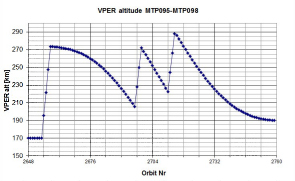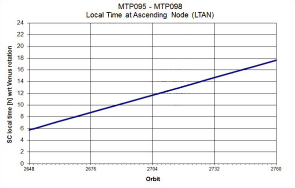No. 265 - End of the twenty-fifth eclipse season, continuation of the first sulphur dioxide campaign, start of quadrature operations
Cebreros ground station
All Cebreros ground station activities were nominal during this reporting period.
End of the twenty-fifth solar eclipse season
The mission's twenty-fifth eclipse season ended on 5 October.
Particular science observations are carried out during eclipse seasons: for further details, see the Scientific Focus section below and 'Science observations with Venus Express during an eclipse'.
Battery charge reconfiguration
The mission's twenty-fifth eclipse season ended on 5 October. The battery's end-of-charge (EOC) state, which had been at 100% for the eclipse season, was subsequently lowered from 25 V to 24.4 V on 12 October.
During solar eclipse seasons, the spacecraft is in complete darkness during a portion of each orbit when Venus blocks out the Sun. At this time, the spacecraft bus and payload are powered by the on-board battery, which must then be recharged again to 100% prior to the next eclipse. The battery (composed of three individual battery packs) is sized so that at the end of its life, the spacecraft can go through the longest eclipse and still retain enough stored power for the spacecraft to successfully complete a transition to 'safe mode' in the event of a spacecraft system anomaly.
Outside eclipse seasons, sufficient battery power must be maintained at all times for a transition to safe mode. However, a lower (than 100%) battery energy level (or end-of-charge state) can be maintained, as no provision is needed for eclipses. Lowering the battery's end-of-charge state prolongs its life.
Orbit correction manoeuvres
Five orbit correction manoeuvres were performed during this reporting period, two on 22 September, and one each on 23, 24 and 25 September.
At this stage of the mission, with low fuel levels on the spacecraft, the orbit correction manoeuvres are carried out as a number of small burns – rather than fewer large burns – to ensure that they are performed accurately. An explanation for this can be found in Status Report no. 257.
Start of quadrature operations
The spacecraft began operating in the inbound quadrature configuration on 1 October. The illumination conditions during quadrature make Earth pointings 'hot' during communications periods with Earth. The spacecraft was kept in the cool orientation for a few hours to recover from these hot pointings, allowing no solar illumination on thermally sensitive faces.
Read more about quadrature operations here.
Continuation of the first sulphur dioxide campaign
Observations of SO2 in the Venusian atmosphere took over as the scientific priority for Venus Express at the end of the twelfth ADE campaign on 27 July 2013; these observations remained the mission's scientific priority in this period.
SO2 is found in small concentrations in other planetary atmospheres. At Venus, however, it is a significant component of the atmospheric chemistry and even forms clouds.
The SO2 observations are performed by SPICAV (Spectroscopy for Investigation of Characteristics of the Atmosphere of Venus), a spectrometer designed to obtain profile measurements (soundings) of the atmosphere during solar and stellar occultations.
For SO2 observations, however, SPICAV is pointed at the nadir (down at the planet instead of the limb as is usual in occultation observations) and observes the sunlight reflected off the clouds. The instrument pointings consist of zig-zag slews back and forth across the sub-satellite point (where a line from the spacecraft to the centre of the planet would intersect with the planet's surface) on the sunlit, day side of the planet.
SO2 nadir observations were performed throughout this planning period.
Summary of main activities
The table below shows a chronology of the main spacecraft bus activities in the reporting period:
| Main activities during reporting period | |||
| AOS = Acquisition of signal; CEB = Cebreros; DOY = Day of year; EOC = End of Charge; MET = Mission elapsed time; NNO = New Norcia; OCM = Orbit Correction Manoeuvre | |||
|
MET (Day) |
Date | DOY | Main Activity |
| 2868 | 15-Sep-2013 | 258 | CEB communications pass. |
| 2869 | 16-Sep-2013 | 259 | CEB communications pass. |
| 2870 | 17-Sep-2013 | 260 | CEB communications pass. |
| 2871 | 18-Sep-2013 | 261 | CEB communications pass. |
| 2872 | 19-Sep-2013 | 262 | CEB communications pass. |
| 2873 | 20-Sep-2013 | 263 | CEB communications pass. |
| 2874 | 21-Sep-2013 | 264 | CEB communications pass. |
| 2875 | 22-Sep-2013 | 265 | CEB communications pass; two OCMs at pericentre. |
| 2876 | 23-Sep-2013 | 266 | CEB communications pass; telemetry to 228 kbps before AOS; OCM at pericentre. |
| 2877 | 24-Sep-2013 | 267 | CEB communications pass; OCM at pericentre. |
| 2878 | 25-Sep-2013 | 268 | CEB communications pass; OCM at pericentre. |
| 2879 | 26-Sep-2013 | 269 | CEB communications pass. |
| 2880 | 27-Sep-2013 | 270 | CEB communications pass. |
| 2881 | 28-Sep-2013 | 271 | CEB communications pass; VIRTIS-M temperature exceeded. |
| 2882 | 29-Sep-2013 | 272 | CEB communications pass. |
| 2883 | 30-Sep-2013 | 273 | CEB communications pass. |
| 2884 | 01-Oct-2013 | 274 | CEB communications pass; start of inbound quadrature operations; VIRTIS-M temperature exceeded. |
| 2885 | 02-Oct-2013 | 275 | CEB communications pass. |
| 2886 | 03-Oct-2013 | 276 | Shortened CEB communications pass. |
| 2887 | 04-Oct-2013 | 277 | CEB communications pass skipped. |
| 2888 | 05-Oct-2013 | 278 | CEB communications pass; end of the twenty-fifth eclipse season. |
| 2889 | 06-Oct-2013 | 279 | CEB communications pass. |
| 2890 | 07-Oct-2013 | 280 | CEB communications pass skipped. |
| 2891 | 08-Oct-2013 | 281 | CEB communications pass. |
| 2892 | 09-Oct-2013 | 282 | CEB communications pass skipped. |
| 2893 | 10-Oct-2013 | 283 | CEB communications pass. |
| 2894 | 11-Oct-2013 | 284 | CEB communications pass skipped. |
| 2895 | 12-Oct-2013 | 285 | CEB communications pass; EOC state lowered to 24.4 V. |
At the end of the reporting period on 12 October 2013 Venus Express was 120 million kilometres from Earth. The one-way signal travel time was 410 seconds. The final oxidizer mass was 15.079 kg and the final fuel mass was 9.165 kg.
Scientific focus
This reporting period falls under the ninety-seventh medium term planning period (MTP), which covered the period from 15 September to 12 October.
The twenty-fifth eclipse season ended on 5 October. The first sulphur dioxide campaign continued during this reporting period. The spacecraft began operating in the inbound quadrature configuration on 1 October, and quadrature illumination conditions began on 2 October.
The Local time at ascending node changed from 11:40 hrs to 14:40 hrs, making the season 'hot'. During such 'hot' periods, pointing the spacecraft at the nadir (towards the planetary centre) exposes its thermally sensitive -Z face, limiting nadir-pointing observations.
Venus Express passed through long solar eclipses during this reporting period. This opportunity was exploited for surface observations in the shadow of Venus. The surface observation targets included Comnena crater (1.2°N, 343.7°E), Gula Mons (21.9°N, 359.1°E) and Sif Mons (22.0°N, 352.4°E).
SO2 observations continued to be the mission's scientific priority during this period. Until the beginning of quadrature operations, day-side nadir observations were conducted during every orbit, and solar spectroscopic sounding observations were carried out during three of every four orbits using the Solar Occultation at Infrared (SOIR) channel of the SPICAV (Spectroscopy for Investigation of Characteristics of the Atmosphere of Venus) instrument.
Quadrature illumination conditions began on 2 October, placing the +Y panel of the spacecraft under a +10 deg illumination during Earth-pointing. Thus, thermal constraints prevented 'hot' observations during this period unless a communications pass was also skipped.
Day-side nadir observations and SOIR observations are both classified as 'hot' observations. In this quadrature period, two to three communications passes were skipped every week to allow the continuation of the SO2 measurement campaign, on a two to four day interval until the beginning of the next Atmospheric Drag Experiment campaign on 29 October 2013.
The Venus Express nadir dayside observations were studying the afternoon quadrant of Venus, which was also visible from Earth. For this reason, the continued SO2 measurements during this period were particularly important for coordination with ground-based measurements.
Payload activities
| ASPERA | The instrument was regularly operated nominally as part of the routine plan. |
| MAG | The instrument was regularly operated nominally as part of the routine plan. |
| PFS | This instrument was not operated. |
| SPICAV | The instrument was regularly operated nominally as part of the routine plan. |
| VMC | The instrument was regularly operated nominally as part of the routine plan. |
| VeRa | The instrument was regularly operated nominally as part of the routine plan. |
| VIRTIS |
The instrument was regularly operated as part of the routine plan.
A previously seen temperature alarm was activated on 28 September and 1 October when the temperature of the radiator of VIRTIS-M (moderate resolution channel) briefly exceeded its limit at 08:39 UTC, 3 minutes before pericentre passage. As observed in the past, this is caused by the geometry of the eclipse season. During the season, the VIRTIS instrument's heat radiator is exposed to light reflected from Venusian clouds in certain orientations. This albedo reflection is enough to heat the radiator, raising its temperature to slightly higher than normal. This has been investigated thoroughly in the past, and does not damage the instrument. |
Future milestones
- Start of the sixteenth occultation season
- High altitude aerobraking flight test
- Start of the thirteenth Atmospheric Drag Experiment Campaign
Legal disclaimer
This report is based on four ESOC mission operations reports, MOR 407 through MOR 410, as well as the MTP97 Master Science Report. Please see the copyright section of the legal disclaimer (bottom of this page) for terms of use.






